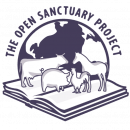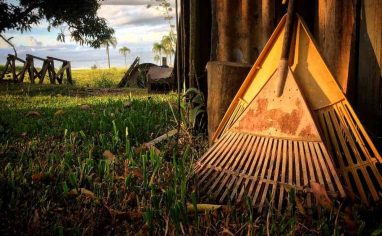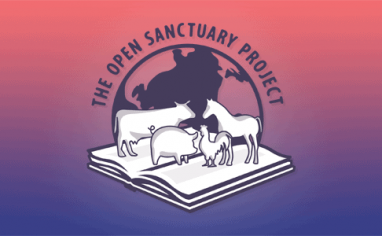
Subscribe To The Open Sanctuary Podcast
If you’d like to get the latest episodes of The Open Sanctuary Podcast, you can subscribe for free on all Podcast platforms, including Apple Podcasts and Spotify!
Episode Notes
Executive DirectorThe individual formally in charge of final decision making at an organization, who sometimes works closely with the organization’s Board of Directors. Sometimes a Founder is an Executive Director, especially early in a nonprofit’s growth stages. Mckenzee and NonprofitA non-governmental organization whose primary purpose is something other than selling goods or services. Specialist Julia have another discussion about sanctuary capacity, this time about cruelty, seizure, bust, and escapee cases. We review all the questions your organization needs to consider before working on these cases. Some of these questions you may anticipate, and some you may not! Please note that we will not get into graphic descriptions of animal cruelty, though we must mention it generally.
—
This Episode’s Referenced Open Sanctuary Project Resources:
- Managing Cruelty, Seizure, And Escapee Cases At Your Animal Organization | The Open Sanctuary Project
- 25 Questions To Help Guide Responsible Intake Decisions At Your Animal Sanctuary | The Open Sanctuary Project
- Care Staff Retention At Your Animal Sanctuary | The Open Sanctuary Project
- An Introduction To Navigating Media Coverage For Your Animal Organization | The Open Sanctuary Project
Episode Transcript (Auto-GeneratedThe following content was transcribed through an automated process and may contain transcription errors or misspellings.)
Mckenzee Griffler: Hello and welcome to another episode of the Open Sanctuary podcast. I am executive director of the Open Sanctuary Project, Mckenzee Griffler, and today I am chatting with my friend and colleague, Julia Magnus.
Mckenzee Griffler: We have had a few podcast episodes all about capacity when it comes to sanctuary work. And today, I’m here to say we’ve got another podcast episode about capacity for you. But this one is a very specific context, and that is your sanctuary’s ability to help out with cruelty cases. And before we go any further, I am going to assure you that out of sensitivity to you, our listener, we are not going to go into any graphic descriptions of animal cruelty, although we must mention it as a general concept. Instead, we are going to talk about the kinds of considerations that everyone at your organization needs to work through before you can decide that you would like to work on cruelty cases. And this is from a very comprehensive resource that Julia put together, and I’m very pleased that she’s willing to talk to us about some of these considerations because we know it can be a heavy topic. We know it’s not something that everyone has experience with, but we also know it’s very important to have this information out there. So, Julia, before you ever touch a cruelty case, a seizure, a bust, or even consider working with an escape case, there are a number of questions that you should as an organization address as a whole with all relevant stakeholders within your organization, and you should go through them carefully, thoughtfully, and with all input given the weight necessary. But even before that, I want to say that your organization should really consider having a rescue policy generally in place. And I want to note that there is a resource on that subject as well as a resource on the challenges of responsible rescue, and a great resource called “25 Questions to Help Guide Responsible Intake Decisions at Your Animal Sanctuary.” We are going to drop those in the show notes. If you haven’t done those things first, please consider checking out those resources and running through those lists. Again, taking into account the input of all relevant stakeholders at your organization to make sure that you have the capacity for what you think you have the capacity for. And keep in mind as well that capacity is a variable that changes over time. The elements of it change over time. And so this is a discussion you should revisit frequently and thoughtfully. So once you have those things, those basic rescue policies in place, and you’ve had these discussions, then I would say is the time you could start thinking about cruelty, seizure, and escape cases. The reason that that should come second is because these kinds of cases have a lot of additional elements and complications that you can encounter, and they can really throw you for a loop if you aren’t prepared for them. Again, as with the initial threshold discussion, include everyone who is relevant and develop consensus on the answers before you work on these cases. And it doesn’t matter if you haven’t been approached by say, animal control or another organization to work on a cruelty case. Have the discussion in advance anyway, because you are going to want to have these consensuses built within your organization before you ever deal with it. Because if you are suddenly confronted with a cruelty case, a seizure, your emotions may be really heightened. It could be something that gets you really worked up to a point where you might have a hard time exercising judgment. You might find yourself having a hard time saying no in the absence of a pre-existing internal organization on the matter.
Julia Magnus: Absolutely. Honestly, like all of our discussions about contingency planning, it’s kind of a similar deal that the more you can all get together and develop a plan and a consensus, the much more successfully you’ll be able to respond to these requests with an organizational alignment that benefits everybody. And just going to underscore again, even if you are not planning on working in this realm of animal rescueAn organization that helps secure animals from dangerous or unacceptable situations. As organizations, rescues may or may not have dedicated permanent infrastructure for housing animals., having a rescue policy is so important for every animal sanctuary because simply saying we are going to accept every animal who needs help is not a sustainable model for any animal sanctuary in the world. Yeah. If I did that, I would have 5 billion roosters by now and everything would be roosters.
Mckenzee Griffler: That’s not the worst fate. I mean, I would love everything to be roosters, but realistically that’s not a, as you said, not a sustainable policy. So as I said, discussion, development, and adoption of a general rescue policy comes first in anything to do with these kind of cases. Ideally, when you start working as an organization and with consensus of all the relevant staff and stakeholders at your organization, and then you can start thinking about a policy on cruelty cases. But when you are having that discussion, let’s say you’ve gotten to that point as an organization, what kind of questions are you going to want to be thinking about and talking about with relevant stakeholders? What kind of discussion should you be having with your staff, should I say?.
Julia Magnus: That’s a really important point and that was the first thing that we went into on that resource because it is really arguably one of the most important parts of this process. So, we created a list of these questions for your discussion, for your process when you are going through this. And we call them threshold questions. You don’t need to worry about writing anything down. They are in that resource for reference when you do have these discussions. Well, let’s run through them one by one. If you want to maybe start with the questions, I can elaborate a bit more on what thought went behind each of those questions.
Julia Magnus: So, question number one, do you have local legal counsel who is knowledgeable about animal cruelty laws? So, famous disclaimer, which I have said a million times, we are not your attorney. We cannot be. You need to find somebody in your jurisdiction with knowledge of your jurisdiction’s animal cruelty laws. We really recommend this, particularly in the case of cruelty, seizure, or escape cases, who can help advise you during this process. And that is going to cover so many elements that you might not expect go along with this kind of work, which includes documentation of expenses, specific recordkeeping, how legal proceedings could impact the case, care that you can provide with these residents, these survivors, and also the ultimate placement of the animal in question. And I stress that this should be somebody within your jurisdiction because state laws do vary when it comes to seizures of animals. And we will get into that a little bit further, but it will vary state by state. And actually within animal sheltersOrganizations, either government-funded and maintained or not-for-profit and funded by charitable contributions, with a physical infrastructure in which homeless animals are cared for and offered for adoption., one shelter in one county might have a very different policy than the one in the next county. So, you want somebody who is very familiar, and you definitely want to get clarity on all of that as soon as you begin. Always, always, always work with qualified professionals who understand where you are and what you are trying to do, and the relevant laws that govern those things. We can never stress that enough. Even though it might seem like an extra expense, it will save you so much heartbreak down the line. Number two, do you have the resources to assist animals who may be in very poor condition and who might be intensely traumatized? So, this is a big one. It is almost inevitable that any sanctuary animal rescue is going to encounter animal suffering, but cruelty and seizure cases can be particularly intense. You may not even be able to get a great idea of the status of the animals in question before you make a commitment to taking them on. So, always make sure you have a really significant buffer of resources to deal with any unexpected surprises you might encounter. You want to ask, do you have an emergency vet, funds that can cover these expenses, and include in that access to behavioral support for animals who may need it? And just because it’s really close to my heart, let me just use the example of survivors of cockfighting. So, these birds can often come in very injured. They might be very fearful. The roosters in particular might have very specific needs around space, living spaces to accommodate them. And they need distance from other roosters. And these are just the beginning considerations. And of course, of course, you are going to need to think about quarantineThe policy or space in which an individual is separately housed away from others as a preventative measure to protect other residents from potentially contagious health conditions, such as in the case of new residents or residents who may have been exposed to certain diseases. capacity. Can you keep these animals away from your existing residents safely through a quarantine period, at least 30 days, but longer if your veterinarian determines that it’s necessary, as long as necessary to have them cleared to be part of your general population, let’s say.
Julia Magnus: So, number three is really important to me. These are all important to me, but number three is really close to my heart. Is everyone, the people, the humans in your organization prepared to deal with the possible trauma you might witness and experience as a result of this? Yeah, it’s really huge. Because these cases are not just traumatic for the animals involved, but also for the folks caring for them. I have personally seen awful things in terms of animal trauma and also witnessed and seen the aftermath of awful human behavior in cruelty cases. And it’s disturbing. It is not something that you leave at the office. You bring it home with you. And I personally have had to seek support from professionals to work through some of these experiences and the trauma that they cause. So, I’m definitely not alone in that. I know many other people in this kind of work who have experienced that as well. So, it’s very important that organizations take that very seriously and ensure not only that they have the resources available to help traumatized animals, but also the resources to provide all of their staff and volunteers who will be directly caring for the animals or involved in the case with the emotional support that they might need during this time. It could look like mental health care, engaging other caregiving facilitators to help support folks, offering folks extra time off so they can recover from this, recuperate. And I think it’s really worth taking a look at another resource that we have, which is called “Care Staff Retention at Your Animal Sanctuary” for even more ideas of how you can provide a supportive environment for your staff. We’ll drop that in the show notes. So yeah, definitely check that out. It’s really, it’s not a joke. This is heavy work.
Mckenzee Griffler: Absolutely. Even without working with cruelty and seizure and escapee cases, it takes an extreme toll working at an animal sanctuary if you don’t have a lot of different support mechanisms. And even if you do, it’s still hard. I know people that no longer work at sanctuaries that are still deeply affected by what happened just working with escapee cases, just working through these systems. And I think it’s just so critically important that sanctuaries know that while they have a responsibility to the animals in their care, they also have a responsibility to the humans that are supporting them in this work to make sure that they’re okay, too. Because compassion fatigueA form of Secondary Traumatic Stress Disorder that can affect anyone serving individuals who have experienced or are currently experiencing trauma. and burnoutA physical and emotion reaction to prolonged, unmanaged workplace stress. are terrible things. And even in the best of circumstances, they can creep up.
Julia Magnus: Yeah. I think it should go without saying. But please do not shame anybody who comes to you saying that they need a break or they need support because what they have seen has taken a toll. Also, it’s worth mentioning at this point that we have resources describing compassion fatigue and burnout on our site. You can search them and we’ll drop those in the show notes as well.
Mckenzee Griffler: That’s a great point, Julia. So, number four, is your sanctuary rescue staff prepared to suddenly deal with new demands on your resources which may persist for a protracted period of time?.
Julia Magnus: I think it’s worth underlining, and I’m so glad that you mentioned protracted period of time, because if the cases that you are working involve the legal system, then the time frame can be very, very long. Some cases can go on for years, and you may well find that you will have to create additional capacity at your organization for all kinds of new needs which are associated with the legal process or the needs of the residents in question. These could include elements like paying staff for overtime work, as well as providing the emotional and other support that they may need. Obviously, veterinary bills are going to be up there, and you need resources for emergency and follow-up care and documentation. And again, you may very well need to segregate and track and document all of the expenses associated with the survivors of cruelty if you are sucked into the legal system, keep them totally separate and accounted for differently than those of your existing residents. And that can be a lot of work. And honestly, you might be hearing all this and say, “Well, this is terribly unfair. This animal already went through a lot, and it’s so much work just to take care of them and make sure they have a good life. I cannot believe all of this is also required in order to give them that long-term good life.” And the answer is it’s not fair, but this is the reality. So, it’s something you really should strongly consider if this is the kind of work that your sanctuary is interested in embarking on. And not only is it not fair, but if we are talking about fair in the justice system, you know, that’s kind of a “hmm,” but if you don’t do the things that you are supposed to do, it actually could undermine any kind of recompense you might get through the justice system, and that would be super unfair and end up costing you a lot more down the road.
Julia Magnus: Yep. So, number five, are you and everyone at your sanctuary prepared to work with law enforcement? This is an interesting one and it’s important, very important. There are people, there are sanctuaries, there are rescues, folks working with or volunteering with your organization, and even veterinarians who may not want to work with law enforcement for a variety of reasons. It doesn’t matter what those reasons are. They are valid, and these sensitivities should be taken into consideration. Sanctuary and rescue community members who do not wish to collaborate with law enforcement should never be put into a position where they are forced to do so. And that may mean that they are unavailable to take the lead or directly assist with the animals in question in cases like this. I recall specifically one bust that I was working on. It actually wasn’t a bust. It was a cruelty case. Sorry. But there was a veterinarian who was involved who absolutely did not want any part of any legal proceeding, any law enforcement activity. And what ended up resulting was that we had to choose another veterinarian to do assessments on the individuals in question. And it is not a good thing for your relationship with your vet if you surprise, “Hey, guess what? These birds that I’ve just brought to you, they’re from a bust.” They might want a heads-up on that and have the opportunity to assess for themselves whether they want that kind of involvement. Because ultimately, it’s not unlikely if the thing went to court that your vet would be hauled into court. And as we know, vets are very busy people. They have enough on their plate. They might not be very appreciative of you involving them in that way. So, this is part of making sure you have your infrastructure ready before you ever engage in these cases.
Mckenzee Griffler: And you know, even beyond vets, anybody who might be interacting with these residents in any capacity might suddenly then be named into different proceedings. And as you said, for a variety of valid reasons, folks might not want to be involved in that. And so that is a critical point and a good segue to our next question, which is, are you or anyone who has taken the lead in caregiving for the animals in question prepared to potentially participate in legal proceedings, including potentially testifying at trial?.
Julia Magnus: Yes. As you said, anyone who has had hands-on, who has participated in day-to-day care, and includes your veterinarian, and this has happened to me. I was subpoenaed. I had the county sheriff come to my door and serve me with a subpoena to testify at trial and had to take the stand for two separate days to be examined and cross-examined on the triage and care of a group of roosters. And it was a lot. I’m a lawyer and it was still a lot. This additional responsibility, it involves time, energy, travel. It’s super stressful. Even if you know what to expect, your recordkeeping, your internal documents, anything that you have said or done is potentially discoverable. It could be made public through court proceedings. If you sent an email to the shelter using a string of obscenities describing whoever the alleged perpetrator was, that could come out in court. It could make you look less than professional. It could undermine your position in court, your expertise. And so you have to be prepared to curate and maintain your records in a manner that can withstand scrutiny in a litigation situation. So while maintaining extensive veterinary records and caregiving observations is absolutely critical and helpful, it can be undermined if you have internal written correspondence that includes non-objective and pejorative language, or just anything that might be a joke within your organization, but it’s an off-color joke. You have to keep all of it very clean, very professional, and be ready for everything to be looked at. And this can be very, very hard to do, especially when your emotions are high when you are involved in such a case. Yeah, it’s a big commitment, and getting involved with the law can be a big commitment, and it is completely valid for you or anyone at your organization to say, “I cannot take that on.” So you mentioned things being discoverable, and that raises the question of public records generally. So question number seven is, are you prepared to carefully curate your correspondence accordingly as all of it is potentially subject to being made public, either through court proceedings as mentioned above, or by media or other groups who might be interested in the story? Yeah. And this is important even beyond seizure and bust cases. Say you are just pulling some stray birds that were at a shelter. If you are writing back and forth with the animal placement coordinators, whatever, and you make some comments or whatever, that is something that can be found through FOIA requests. So, if you correspond with government agencies like municipal shelters or law enforcement, you should be aware that all of your written correspondence could be subject to the Freedom of Information Act, otherwise known as FOIA. So again, curate your correspondence accordingly, like as if it’s going to be seen by the public. What if the media catches wind of a story like this and decides to FOIA records from say, the shelter, and those things get publicized in a media story, you could look pretty “yick,” depending on what you have or have not said. And so maintaining records in a manner that’s free of language that could cast doubt on your objectivity, your professionalism, or cast a negative light on your organization, it’s really important. Absolutely. Number eight is, I am going to say, one of the hardest ones in this list, which is, if seized animals are ordered to be returned to their former keepers, are you prepared for the emotional toll that this may take on those who have cared for them, in addition to the possibility that you may have to absorb the costs of the resources that your organization has expended to care for them? Yeah, this one’s really hard. Get ready for lots of “air quotes.” Unfortunately, this is the “yuck” reality that we live in right now. So, starting with seizures, let’s say it’s really important that you remember that just because animal control has seized a group of animals, that does not necessarily mean that the animals are now “property” of the state or that their “ownership” is immediately transferred to the new caregivers after seizure. In general, until that happens, animals are considered to be evidence. They are still the property of their former keepers until they are surrendered by that keeper or until a court adjudicates the matter. Again, this is a point where it’s really critical that you have knowledgeable local legal counsel who is familiar with the laws that apply to these situations in your state because they will vary. So how ownership is transferred or seizure is warranted can vary widely depending on the circumstances. Generally after seizure, officials might offer the keeper who has ownership of the animal or animals the opportunity to elect to surrenderThe act of transferring guardianship of an animal to a person or organization, especially via legal contract. them, at which point they become property of the state and the ownership shifts to the governing authorities who may then transfer to you or to other rescues, or they may make decisions of their own which could include options that we shouldn’t get into too deeply, but it may include ending the life of those animals. If the keeper does not opt to surrender the animals, then the animals remain their property even though they are in the custody of the state pending judicial resolution. At that point, you may very well face the fact that you are limited in the kind of veterinary care that you offer. While you may offer a certain kind of gold standard level of care for animals at your sanctuary, you may not be able to offer that same care to animals who are in this sort of ownership limbo pending judicial resolution. So, in this case, these animals might have to sort of exist in this limbo until the former keeper ultimately decides to relinquish them, which can happen. It can happen as part of a plea bargain or until the court decides the case and then makes a decision as to whether they are going to be returned to their former keeper or become property of the state, which will then become responsible for adoption and placement. So, just remember this. This is a matter of control, and you may not have all the control you want and need to do all the things that you want for these animals. You may not be able to transfer them out of state. This could limit your ability to get help with fostering. It can have impacts again with regard to your care and the documentation of your care. You might even find that your veterinarian doesn’t want to work with animals who are in ownership limbo because they might be concerned that if the animals are returned to their former keeper and that person is disgruntled, they might be concerned about liability for any treatments they may have done on these animals. So this is a very tricky place to exist, both for the animals and for those who are trying to care for them, and it can be very anxiety-inducing, and it can go on for a very long time. So if you don’t have capacity to cope with this, that’s understandable, but it’s definitely something you are going to have to think about in advance.
Julia Magnus: And you know, just to underscore the emotional toll of working with animals who have suffered and spending all of these resources and all of your emotion on getting to know them as individuals and providing them what they deserve, providing them with health care, providing them with all of these things. It can be absolutely devastating, and I’ve seen it. It can be devastating to caregivers, to staff, to volunteers for these residents to be returned to their former keepers. And that is a reality that you need to be prepared to interface with any time you are going through these proceedings. You know, there’s the old adage, “possession is nine-tenths of the law.” That zero percent applies when it comes to these kind of cases. And I will even say that, and this happened to me as recently as last week, I was dealing with a case where animals were seized. The animals were in shelter. They were property. They were surrendered by the owner. And I was ready. I was making preparations to pull and place these animals when the shelter made an unfortunate and I would say ill-informed decision to end their lives. So, I was ready. I had them all in my hands. And yet, they were not transferred to me yet, even though they were property of the state. And then they were killed. And this is the kind of thing that can happen. It’s devastating, particularly when you’ve had your hands on them. And it can happen. It has happened to me. It has happened to others. And it’s very, very hard to get through that. So, I just I want to kind of send some love to those creatures who lost their lives this way. It was unnecessary, and it is very hard.
Mckenzee Griffler: And I want to send some love to you for having gone through that and knowing that you went through that many times because that is not easy.
Julia Magnus: Yeah, it is rough. It is very rough, which is again, I want to kind of go back to, have community support, have mental health care support if you need it, because there are going to be times where you do.
Mckenzee Griffler: Number nine, are you willing to take precautionary measures to protect animals coming from such situations, such as additional security on your property and keeping information of these animals off of social media in order to protect their safety and the integrity of any ongoing investigation?.
Julia Magnus: Yeah, this is big too, because sometimes cruelty and seizure cases can involve people who don’t operate under great intentions. Sometimes the humans involved might want to get their animals back. And so if you have them in your possession from these kinds of situations, whether they are technically your property at that point or not, you might be exposed to risk. Again, I’ll go back to cockfighting. It’s the thing I’m most familiar with in these kinds of cases, but there are high stakes involved with cockfighting. The birds are, “air quotes” again, worth a lot of money. Folks are very eager to get their hands on them or get them back. I’ve worked with many colleagues who have had to, I have too, implement robust security measures to protect their survivors. And that includes securely locking enclosures, installing camera systems, motion detectors, it even more, it goes on. It’s a lot, and that’s again resources you have to invest to protect them and also yourself. So you can see why this one metric of capacity is really quite an involved one, and it is to say it one more time, perfectly valid and reasonable if your organization at this time doesn’t feel resourced to properly take on these cases, that’s totally fine. But if you are interested, all of these considerations are absolutely critical.
Mckenzee Griffler: And if you are, if you’re still with us and you are still into the idea of trying to do this work, definitely go check out the resource because there’s even more nuggets of wisdom in there for you. And we have one more question to ask yourself as an organization, which is, are you as an organization and the individuals associated with it prepared to cope with potential outside media attention?.
Julia Magnus: Yeah. So many sanctuaries and rescues welcome media attention to draw the public eye to their work, their missionThe stated goals and activities of an organization. An animal sanctuary’s mission is commonly focused on objectives such as animal rescue and public advocacy., their vision, and supporting animals in need of care. But sometimes when the media gets involved, narratives have a way of finding a life of their own. And given that media timelines are typically pretty short, you can often find that inaccuracies easily find their way into stories and can create misunderstandings in the long run. And accuracy and transparency should be important values for your animal organization. And that includes to the public and the media. And if the media somehow works in an inaccuracy due to a short time frame that could potentially be attributed back to you, not the media in question. So I recommend we do have a wonderful resource that is called “An Introduction to Navigating Media Coverage for Your Animal Organization.” It was authored by writer Hemi Kim with contributions from our staff, and it will lay out for you some of the pitfalls, things to look out for when you are dealing with media and give you some tips and tricks. It’s not just helpful in the context of cruelty, seizure, and bust cases, but it’s also a good read for anyone who might find themselves dealing with media.
Mckenzee Griffler: Yeah, it’s a great read and another good tool in your bandolier of tools when you are working with this very complicated situation. And that’s the 10, that’s the 10 questions. As Julia had said, they are all beautifully outlined in a resource on our website that you can read at any time. You can print it out if that would be helpful for you, too. And there’s a lot of great additional context, a lot of great nuance, some extra questions, some wisdom. And we really hope that if this is something that you are strongly considering getting involved in or if you are volunteering for an organization who is thinking about getting involved, please consider sharing this resource. Read it through, ask questions, ask us questions. If, for instance, something in this resource doesn’t make sense to you or you have additional complications. We are not your legal counsel. Julia, our wonderful attorney, is not your attorney. So, we cannot answer most things. And we will probably say to go talk to relevant counsel in your jurisdiction, but we have some generalized knowledge that if you have questions, we might be able to point you in the right direction, which is not legal advice. However, that will do it for this episode. We know it’s a little bit of a heavier one than most of our podcast episodes go, but we really appreciate you sticking with us if you’re still here listening. And I am so grateful for you, Julia, for all of the work that you have done through the years to help animals in these situations and for sharing this knowledge so compassionately and succinctly with the world.
Julia Magnus: Well, I’m definitely grateful for OSP for being a platform for not only this, but all the brilliant brain workings of the whole team and that it’s freely available to everybody who needs this information. So, as always, we welcome your feedback. If you found this information valuable or other information that we’ve shared, please consider leaving us a five-star review and a little rating on Apple Podcasts or on Spotify. And if you like what we do and you would like to support our work, we warmly welcome donations. We are a 501(c)(3) organization in the United States. So your donations are tax-deductible and they help us sustain our mission of continuing to provide freely accessible resources so that every sanctuary is a success story. Thank you so much for listening. Thank you for your support and we look forward to talking to you next time.

Got A Podcast Idea? Contact Us!
If you have a topic or question you’d love to hear our staff address on The Open Sanctuary Podcast, please get in touch via our contact form!








